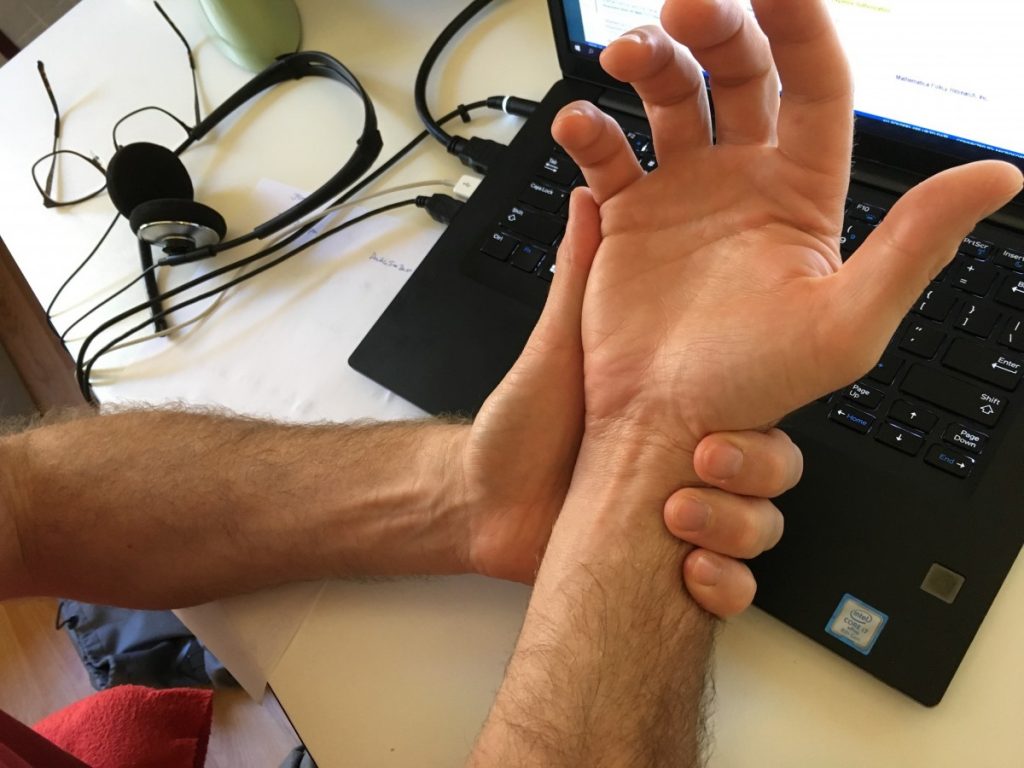
Carpal tunnel syndrome is a common condition in which the wrist experiences numbness, tingling and/or pain. The causes of carpal tunnel syndrome can include many factors such as disease and hereditary pre-disposition, but can also be triggered by stress on the wrist from repetitive motion.
What is carpal tunnel?
Carpal bones are small bones in your wrist that together create a small “tunnel” to connect the arm with the hand. At the top of the tunnel is the transverse carpal ligament, or a tight band of tissue which does not allow for much space to stretch. The flexor tendons, which help bend the fingers, go through the carpal tunnel, as does the median nerve, the main nerve of the hand.
What is carpal tunnel syndrome?
Carpal tunnel syndrome is pain or numbness caused when pressure is placed on the median nerve due to swelling of the tissues around the flexor tendons and when the tunnel itself is narrowed as a result of swelling.
The symptoms of carpal tunnel syndrome include numbness and tingling in the fingers, which may sometimes travel up the arm towards the shoulder. There may be pain and even burning in the fingers, and as a result, weakness in the hands which makes fine motor skills difficult, such as writing. Occasionally, you may experience sudden, sharp pain in the fingers, usually in the first four. Symptoms tend to come on slowly and will come and go, but may persist over time. They are also more commonly experienced at night while people sleep, and while people hold something requiring a bent wrist, such as driving, holding a book or using a phone.
What causes it?
The most well-known culprit is repetitive motion of the wrist such as typing at a computer in a poor hand position. However, other factors can cause it, most notably genetics. Other causes include pregnancy, in which hormonal changes can create swelling in the wrist; diabetes; rheumatoid arthritis; and thyroid gland imbalance.
How is carpal tunnel syndrome diagnosed and treated?
To diagnose carpal tunnel syndrome, the doctor will check your wrist by bending and flexing it and performing a series of tests. He or she may use a nerve conduction study or an electromyogram (EMG), or take an x-ray, ultrasound or MRI. These will allow for a more accurate diagnosis.
Once diagnosed, the doctor will recommend any of the following:
- Wearing a brace to prevent bending of the wrist, particularly at night. It will also help with activity during the day.
- Taking over-the-counter pain relievers to reduce swelling and inflammation.
- Changing work ergonomics or whatever repetitive activity is causing the wrist to bend.
- Administering steroid injections for temporary pain relief.
- Prescribing physical therapy, in which the physical therapist will work with you on exercises that allow the median nerve to move more freely.
- Considering surgery, but only if all other options do not help alleviate the symptoms and if the severity of the condition requires it.
How is carpal tunnel syndrome prevented?
Frequent rest breaks are important to prevent carpal tunnel syndrome. If you spend your entire day typing at a computer, make sure that your desk is set up ergonomically to prevent awkward wrist position. Consider investing in a keyboard that curves to the hand’s natural positions and a gel wrist pad to prevent resting your wrist on a hard surface. During rest breaks, stretch and roll your hands and wrists. Practice improving your grip with stress balls to strengthen the area.
If you’re experiencing any pain or tingling, visit a physical medicine doctor to make sure the diagnosis is, in fact, carpal tunnel syndrome, and have a physical therapist work on a few exercises to keep the pain at bay before it worsens.
